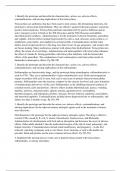1. Identify the prototype and describe the characteristics, action, use, adverse effects, contraindications, and nursing implications of the tetracyclines. Tetracyclines are antibiotics that have been used to treat serious, life -threatening infections, the prototype is tetracycline hydrochloride. They are effective against both gram -negative and gram -
positive microorganisms. Tetracycline penetrates microbial cells by passive diffusion and an active transport system. It binds to the 30S ribosomes and the 50S ribosomes and inhibits microbial protein synthesis. Administration is for the treatment of chronic bronchitis, gonorrhea, and syphilis. Adverse effects inc lude hypersensitivity such as rash, urticaria, serum sickness, or anaphylaxis, pancreatitis, and staphylococcal enterocolitis. Contraindications include renal failure, known hypersensitivity to the drug, less than 8 years of age, pregnancy, and women who are breast -feeding. Many medications interact with tetracycline hydrochloride. Tetracycline also affects the action of several drugs. Administering oral anticoagulants with tetracycline enhances the effect of vitamin K. Giving penicillins with tetracycline interferes with the bactericidal effects of the penicillins. The combination of oral contraceptives and tetracycline results in diminished contraceptive effects. Pg 388 -390 2. Identify the prototype and describe the characteristics, action, use, adverse effects, contraindications, and nursing implications of the sulfonamides. Sulfonamides are bacteriostatic drugs, and the prototype being trimethoprim –sulfamethoxazole is used for UTIs. They act as antimetabolites of para -aminobenzoic acid, which microorganisms require to produce folic acid. In turn, folic acid is necessary to pr oduce bacterial intracellular proteins. Sulfonamides enter the reaction, compete for the enzyme involved, and cause formation of nonfunctional derivatives of folic acid. Sulfonamides act by inhibiting bacterial synthesis of essential nucleic acids and prot eins. Adverse effects include abdominal pain, nausea, vomiting, diarrhea, anorexia, and pancreatitis, aplastic anemia, agranulocytosis, eosinophilia, thrombocytopenia, and leukopenia, pruritus, urticaria, Stevens -Johnson syndrome, renal failure, and inters titial nephritis. Contraindications include known hypersensitivity to sulfonamides, and infants less than 2 months of age. Pg 392 -394 3. Identify the prototype and describe the action, use, adverse effects, contraindications, and nursing implications for the adjuvant urinary antiseptic agents used in the treatment of urinary tract infections. Nitrofurantoin is the prototype for the adjuvant urinary antiseptic agents. The drug is effective towards UTIs caused by E. coli, S. aureus, Enterobacter, Enterococcus, and Klebsiella. Administration of nitrofurantoin with food aids in absorption and decre ases the onset of adverse effects. Older adults shouldn’t take the medication because of the risk of renal, pulmonary, and hepatic toxicities. Contraindications include renal insufficiency and pregnancy —in the first trimester. reporting symptoms such as so re throat, fever, bruising, or rash to the health care provider. Rash and pruritus are the most common adverse effects. Pg 392 -394 4. Implement the nursing process in the care of patients being treated with tetracyclines, sulfonamides, or urinary antiseptics.




